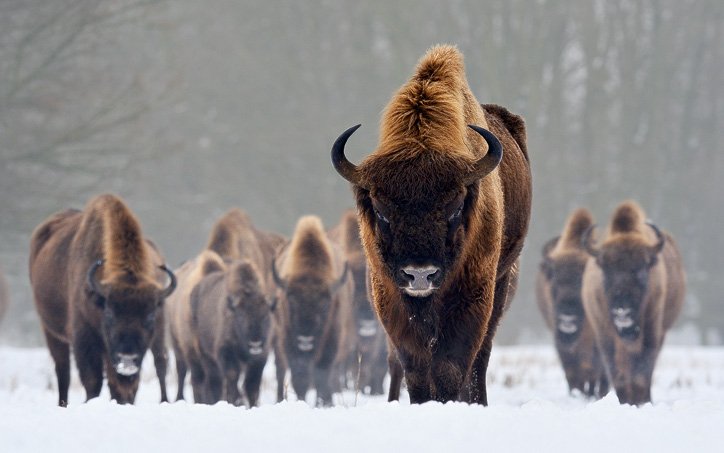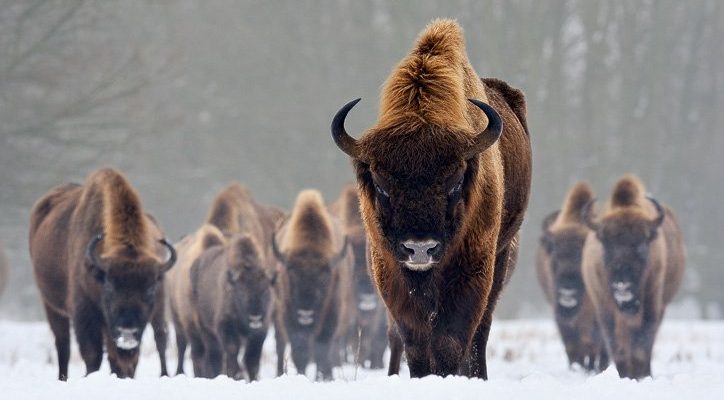
These magnificent animals once faced severe threats, teetering on the edge of extinction. Luckily, they’ve made a comeback thanks to dedicated conservation efforts. There’s something heartwarming about hearing stories of their revival, much like the underdog in a movie who rises against all odds. So, let’s dive into ten intriguing facts that will not only expand your knowledge but might also inspire a little wanderlust to see these incredible creatures in their natural habitat.
1. The European Bison’s History
The European bison has a history as rich as its coat. Once prevalent throughout Europe, they played a vital role in the ecosystem, grazing on the lush vegetation of forests and meadows. However, by the early 20th century, they were hunted to near extinction. It’s astonishing to think that only a handful of these majestic animals remained in the wild, hidden away in tiny pockets of Europe’s forests.
In fact, the last wild European bison was killed in 1927 in Poland. This led to a concerted effort among conservationists to save the species. Breeding programs were initiated, and thanks to the careful management of the few remaining bison in captivity, they began to repopulate areas in Europe. Imagine having to rebuild a population from just a few individuals; that’s what those early conservationists faced!
2. Physical Characteristics
Have you ever seen a European bison up close? They are truly impressive. These animals can weigh between 1,000 to 2,200 pounds and stand about 6 feet tall at the shoulder. Their large, muscular bodies are covered in shaggy fur, which can range in color from dark brown to a lighter tan, depending on the season.
One of the most distinctive features of the European bison is its large, rounded hump on the shoulders. This hump is made up of powerful muscles that support their strong necks. When you see them lumbering through the forest, it’s almost like watching a living piece of history—there’s something majestic about their movements.
3. Their Diet and Role in the Ecosystem
You might be wondering what these gentle giants love to munch on. European bison primarily feed on grasses, leaves, and shrubs. They’re herbivores with a hearty appetite, consuming up to 100 pounds of food daily! This grazing habit plays a vital role in their ecosystem.
When bison roam, they help maintain the health of the forests and meadows. Their grazing prevents certain plants from overgrowing, which allows for greater biodiversity. Imagine them as nature’s lawnmowers—keeping the landscapes balanced and thriving.
4. Social Structure and Behavior
European bison are social animals that often live in small herds, typically consisting of females and their young. The males tend to be solitary or form small bachelor groups, coming together with the females only during the mating season.
Their interactions within the herd can be quite fascinating. They communicate through vocalizations and body language, much like we do. You might see them nuzzle each other or engage in playful sparring, especially among the younger males. It’s heartwarming to observe their strong social bonds and how they care for one another.
5. Conservation Success Stories
When you think about conservation, the European bison is a shining example of success. Thanks to dedicated efforts, the population has grown from just a few dozen individuals in the early 20th century to several thousand today. Isn’t that an inspiring turnaround?
Organizations across Europe work hard to protect their natural habitats and ensure their safety from poaching. Many reserves and national parks now provide safe havens for these animals. Sites like the Bialowieza Forest in Poland and Belarus are prime spots to see European bison in the wild. It’s a testament to what we can achieve when we prioritize conservation.
6. Breeding Programs
Breeding programs have been crucial in the revival of the European bison. These programs focus on genetic diversity and the health of the population. By carefully selecting breeding pairs, conservationists aim to ensure that the bison remain robust and resilient.
Let’s face it: diversity is essential in any species. With a strong genetic pool, they’re more likely to adapt to changes in their environment and resist diseases. It’s like assembling a team of superheroes, each with unique strengths to overcome any challenge!
7. Cultural Significance
The European bison holds a significant place in European culture. They’ve been a part of folklore and traditional stories for centuries. In some cultures, they symbolize strength, resilience, and connection to the earth.
You might find bison images on artwork, coins, or even as mascots for conservation organizations. Their presence serves as a reminder of the importance of preserving wildlife and the landscapes they inhabit. It’s interesting to think how one animal can embody so much meaning across different cultures!
8. Current Distribution and Habitat
Today, European bison can be found in several European countries, including Poland, Belarus, Germany, and Lithuania. They thrive in forested areas, where they can find ample food and cover. But their habitats are still under threat due to human activities like logging and agriculture.
It’s essential to keep an eye on their distribution and habitat health. Conservationists continue to monitor their populations and advocate for protected areas. Every time we take steps to preserve their environment, we help secure a future for these incredible creatures.
9. Fascinating Adaptations
European bison have adapted well to their environments over the centuries. For one, their thick fur not only keeps them warm during chilly winters but also helps them blend into their forest surroundings. Their large hooves are perfect for traversing snowy terrain and soft ground, giving them an advantage over predators.
Another interesting adaptation is their strong sense of smell. They can detect food and potential dangers from quite a distance. It’s like having a built-in GPS that helps them navigate their world better. These adaptations make them well-suited for survival in their habitats, even in challenging conditions.
10. The Future of the European Bison
Looking ahead, the future of the European bison is cautiously optimistic. Thanks to continued conservation efforts, their numbers are steadily increasing. Yet, challenges remain. Climate change, habitat destruction, and poaching are constant threats.
It’s up to all of us to support initiatives that protect these remarkable creatures. Whether it’s advocating for conservation policies or visiting reserves to see them in person, every action counts. The story of the European bison isn’t just about their survival; it’s a reminder of our responsibility to protect the planet’s biodiversity.
As we wrap up our exploration of the European bison, it’s clear that these gentle giants continue to capture our imagination and inspire conservation efforts across Europe. By understanding their importance and supporting their habitats, we can help ensure that future generations get to appreciate their presence just as we do today. So, next time you wonder about wildlife conservation, think of the European bison and the hope they represent!

